In the last two parts of this series we have covered some of the basics of the game such as what cause stops in play and a few ways to get a minor penalty. Over the years the Columbus Blue Jackets have had quite a few minor penalties but also some more drastic penalties. Today we are going to cover penalties that cost the team more than two minutes each.
One of the more interesting penalties in the game is high sticking. We just saw Markus Hannakainen get called for this putting the Columbus Blue Jackets in a tough situation against New Jersey. The basis of the penalty is that a players stick can’t make contact with the head of another player.
If contact is made for any reason, intentional or not, then the penalty is assessed and the offending player is sent to the penalty box.
A high sticking call can result in either a two minute penalty or it can become a four minute penalty. The difference in the calls is one of the more straight forward in hockey. If the player is bleeding from the high stick then it is a four minute penalty. If there is no blood then it stays a two minute penalty.
More from Union and Blue
- Blaming Columbus Blue Jacket Players for Babcock Fallout is Unfair
- The Mike Babcock Experiment in Columbus Has Failed
- Blue Jacket Prospects Win Traverse City Tournament: Who Stood Out?
- Mike Babcock Resigns as CBJ Head Coach: Reaction
- New Claims Bring Higher Level of Concern to Babcock Situation
My favorite, one of the more fun penalties in hockey, and the reason that a lot of people watch is fighting. I was actually surprised when I started watching hockey that fighting was a penalty. Wasn’t that what hockey was all about? In the more recent years fighting is frowned on more and more by the NHL but fans still love it.
The penalty for fighting is also one of the more strange ones. It is a five minute penalty for each player that dropped their gloves in the fight. Since there are generally two people that were in the fight there is no man advantage or four on four play. The penalized players sit out and is immediately replaced in a standard five on five. Once the penalty is over the penalized players must wait until there is a stop of play after their time expires to leave the box.
Fighting and high stick penalties round out the main stops of play so next time around I will start delving into other realms of play. Why are there three numbers in a win/loss? What is a defenseman versus a forward? We will get into this and more as the series continues.
Join me next time as we make sure that anyone can enjoy the game of hockey and learn the ins and outs in a judgement free zone.
